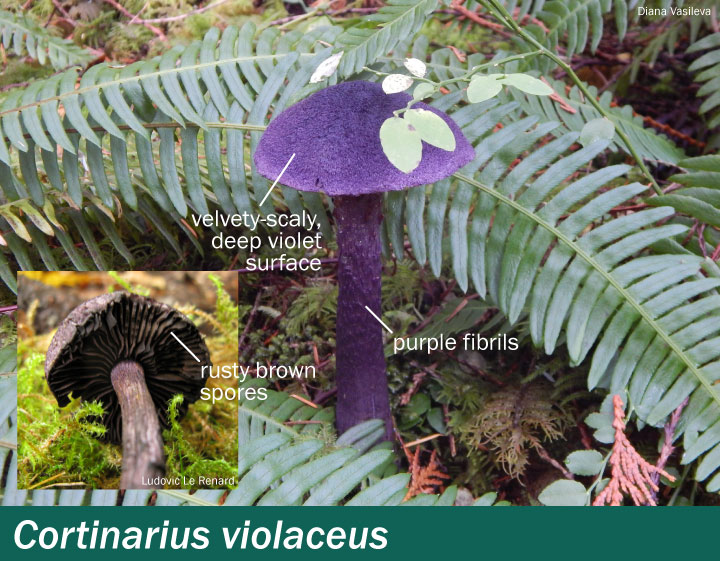Cortinarius violaceus — Violet webcap
Odour: reminiscent of cedar wood.
Cap: 5-12 cm in diameter, hemispherical when young, expanding to convex or almost flat, often with a conspicuous bump in the centre. The colour is a deep violet to deep purple and does not change with drying. The surface is dry, and completely velvety-scaly. The flesh is thick, violet. A drop of 3% KOH will turn the flesh blood red.
Gills: moderately close to well-spaced and broadly attached to the stem. The colour is a dark deep violet that becomes rusty brown from the spores.
Stems: 6–15 cm long x 1–2 cm wide, distinctly longer than the cap is wide. Often gradually widening towards base, sometimes cylindrical. Completely covered with purple violet fibrils that are arranged lengthwise. The flesh is pale lilac to purple.
Ring or veil: remnants of the fibrillose veil will stay on the stem and are visible when the rusty brown spores fall on them.
Cup: none.
Spores: 11.5–14 x 7.5–9 µm, brown, rough.
Habitat: on the ground, in the Pacific northwest and BC often in mixed forests with Sitka spruce (Picea sitchensis), western hemlock (Tsuga heterophylla), pines (Pinus sp.) and hardwoods such as oaks (Quercus spp.). Ectomycorrhizal.
Geographic Distribution: throughout temperate parts of North America and Europe.
Treatment: Contact your regional Poison Control Centre if you or someone you know is ill after eating any of the webcaps. Poison centres provide free, expert medical advice 24 hours a day, seven days a week. If possible, save the mushrooms or some of the leftover food containing the mushrooms to help confirm identification.
Poison Control:
British Columbia: 604-682-5050 or 1-800-567-8911.
United States (WA, OR, ID): 1-800-222-1222.


